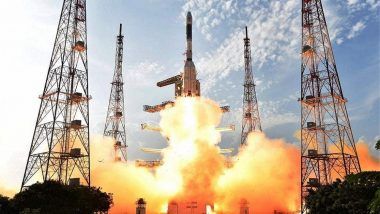Mumbai, February 5: After many successful launches in the past, the Indian Space Research Organisation (ISRO) is now aiming to make the Chandrayaan-2 mission a major success. Chandrayaan-2, India's second mission to the Moon is a totally indigenous mission and is planned to be launched during the first half of 2018. The second lunar mission comprises of an Orbiter, Lander and Rover and is aimed at sending photos of the moon to the Earth in 15 minutes. As per reports, the rover is believed to spend 14 days on Moon, after which, it will go in sleep mode.
According to ISRO, this mission will use and test various new technologies and conduct new experiments. The wheeled rover will move on the lunar surface and will perform the on-site chemical analysis. The data will be relayed to Earth through the Chandrayaan-2 orbiter. As of December 2015, the mission has an allocated cost of ₹603 Crore (US$91 million).
ISRO chairman Dr K Sivan was quoted by TOI saying that the second lunar mission is a challenging mission and the launch will take place somewhere in April. “Chandraayan-2 is a challenging mission as for the first time we will carry an orbiter, a lander and a rover to the moon. The launch date schedule is sometime in April. Once the GSLV rocket carrying the spacecraft is launched from Sriharikota, the orbiter will reach the moon's orbit in one to two months. (The moon's orbit is 3,82,000km away from the earth's surface)."
Here’s all you need to know about India’s second mission to the moon- Chandrayaan-2:
- The mission will carry a six-wheeled Rover which will move around the landing site in the semi-autonomous mode as decided by the ground commands.
- The Chandrayaan-2 will be launched somewhere in April this year, ISRO Chief said. The launch date will, however, depend on various factors like the moon's relative position with respect to the Earth.
- The rover will then send data and images of the lunar surface back to the Earth through the orbiter within 15 minutes.
- The Rover will spend 14 days on Moon, after which it will go in a sleep mode.
- The instruments on the rover will observe the lunar surface and send back data, which will be useful for analysis of the lunar soil.
- The rover's mass will be about 20 kg (44 lb) and will operate on solar power. ISRO says this mission will use and test various new technologies and conduct new experiments.
- The Chandrayaan-2 will weigh around 3290 kg and would orbit around the moon to perform the objectives of remote sensing the moon.
- The payloads will collect scientific information on lunar topography, mineralogy, elemental abundance, lunar exosphere and signatures of hydroxyl and water-ice.
- The rover has been designed in such a way that it will have power to spend a lunar day or 14 Earth days on the moon's surface and walk up to 150-200 metres.
- As per reports, all the three components of the lunar module are almost ready and their integration is underway.
In ISRO's second mission to the moon, the lander will make a soft landing to then deploy the rover unlike Chandrayaan-1's Moon Impact Probe, which impacted the Moon's surface. The lander will not perform any scientific activities. The approximate mass of the lander and rover is 1,250 kg (2,760 lb). Initially, the lander was slated to be developed by Russia in collaboration with India.
As per details on the ISRO website, after reaching the 100 km lunar orbit, the Lander housing the Rover will separate from the Orbiter. After a controlled descent, the Lander will soft land on the lunar surface at a specified site and deploy a Rover. Soon after, the 6-wheeled rover fixed within the lander will get detached and move on the lunar surface.
(The above story first appeared on LatestLY on Feb 05, 2018 11:21 AM IST. For more news and updates on politics, world, sports, entertainment and lifestyle, log on to our website latestly.com).













 Quickly
Quickly












